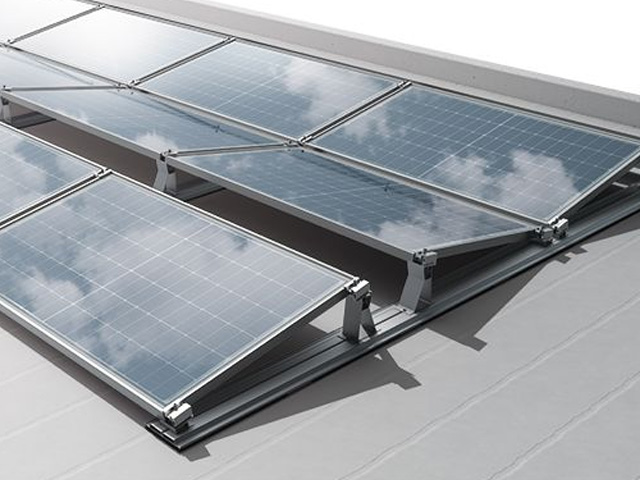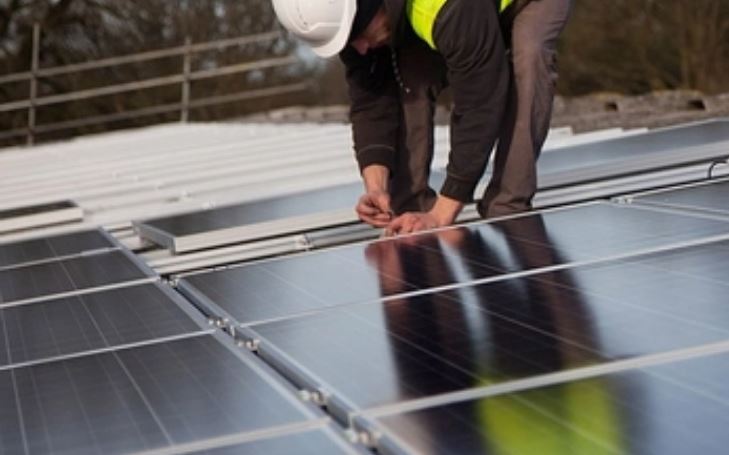The world is getting revolutionized, and throughout the parts, renewable energy sources seem to be popularized, especially the use of solar panels to divert energy usage from nonrenewable to renewable sources that are safe, secure, and in excess.
Keeping that in mind, most users wish to opt for panels with flat roofs, but can users go for mounting solar panels on a flat roof without drilling?

As solar experts, we come across many roof types, panels, and mounting systems, but what to opt for a flat roof?
To answer your query, we devised the roof installation method and procedure to inform the user and enable them to opt for the one best for their roof type.
However, having a flat roof, no worries! Install solar plates without damage and power the house with clean energy.
Mounting Solar Panels on Flat Roof Without Drilling
Each relies on a specific method based on different roof types and mounting systems.
A flat roof ballasted mounting design is considered the best to ensure safe mounting and solar plate installation without harming the flat roof, as in the case of drilling methods.
You need to opt for a ballasted system containing frames, concrete carriers, screws to tighten the panels, and solar panels to initiate installation.
Always get the help of an expert to get a secure and hassle-free installation. Want to know more about solar installation on the flat roof? Just stay tuned!
Roof Types and Preferred Installation Methods
Before installing solar panels, you must be careful regarding mounting solar panels on a flat roof without drilling.
The roof type you own and its compatibility with the solar panel’s mounting system seems crucial.
Some might require drilling, while another opts for a mounting system.
So, on a general note, let’s see how roof types require different mounting systems, but our main concern for today would be on flat roofs requiring ballasted mounting. Common roof types and panel installation methods include;
Roof types – Solar panel installation methods
Flat roof – Ballasted Racking
Asphalt shingle roof – Penetrating Mounts or Thin- PV Film Solar Laminates
Pitched rooftop – Flush-Mount Racking
Tile roof – Penetrating Mounts or Mounting Brackets and Rails
Standing Seam Metal Roof – Clamps or Drill-Free Attachment
Motorhome roof – Sikaflex 252i
Drilling through a flat roof makes it prone to more leakage changes, causing overall roof damage and many other issues, and most of the traditional solar systems require drilling, so what’s next?
Mounting solar panels on a flat roof without drilling! As discussed earlier, innovative new methods were invented, among which ballasted systems, the most common ones opted for a flat roof to mount solar systems without drilling and damaging the roof.
Prerequisites
Remember to analyze the solar panels, their purchasing, installation, and labor cost, go for purchase and measure roof surface area, and analyze roof type.
Once you are okay with these factors, grab a handy procedure to mount the panels and power up your house without getting confined to costly electricity.
Ballasted Mounting System
Mounting solar panels on a flat roof without drilling or the Ballasted mounting for solar panels is considered one of the most common systems that can better handle the Solar Panel weight without the need to drill the roof type for panel installation.
Ballasted mounts contain concrete blocks that secure the panels’ heavy weight. Another benefit the Mount provides is to keep the panel safe from heavy winds or other factors.
Compared to the two other methods, they are a bit less costly to install, and stability-wise, users get fear-free of damaging the roof surface.
So, flat roofs do require a ballasted system, but how are they installed? Let’s check it out.
Procedure
Roof type and method selection
Before installing the ballasted system, first, you need to know whether your roof type can handle the weight of the system or not because some roof types are not that strong, so both drilling and ballasted system can affect its longevity and structure.
Once you confirm the roof strength, purchase the ballasted system.
Panel and frame purchasing
While purchasing, remember that you have already measured your roof dimensions and the number of solar panels you require.
Based on that, you would inform the supplier and get the desired number of frames per installation criteria.
Iron Ridge BX ballasted system.
Purchase the Iron Ridge BX ballasted system offering secure and tight inter-row spacing with a frame designed with a concrete carrier that would be required to hold the concrete blocks to maximize the weight.
Installation
Now that you have the panels, frames, and concrete carriers with the calculated dimensions and angles, it’s time to go for the main installation procedure.
Panel fixation over frames
On the desired site, the plates will get replaced where you wish to keep the panels.
They are being secured with the Iron Ridge BX so that it gets fit and connects them using the mid and end clamp.
Add a concrete block to the substantial carrier.
Once secured, you can add a concrete block to the concert carrier to increase the weight and holding capabilities of the frame. It would prevent the frame from leaving its site in case of strong winds.
The ballasted plates and Iron Ridge BX seem enough to hold the concrete block longer without getting damaged.
Finalizing the installation
Add a concrete block; you get done installing the panels on a flat roof.
Wirings and connections
Go for the further procedure of adding wirings and batteries to make your solar system work and keep powering your house or building.
Solar panel mounting angle and cost for flat roofs
When installing the mounting system on the flat roof, maintain an angle of 30 to 40 degrees to make the panels able to catch a maximum of solar energy and efficiently provide power.
The overall cost for flat roof panel mounting would be about £750 to £900/kW in the US region. The price may vary based on the number of panels and labor costs for specific areas.
Benefits of Mounting Drill-Free Solar Panels on Flat Roof
- Prevent water leakage or surface deterioration over time.
- Installing the ballasted system is easier than other methods, like thin film panels.
- Fit most of the solar panels.
- Secured from heavy winds and storms in stormy weather.
- No permanent attachment to roof casing damage.
- Easy to clean.
- No hassle while unmounting.
Conclusion
Mounting solar panels on a flat roof without drilling gets much easier with the invention of ballasted mounting that secures the solar panels without relying on drilling and roof damage.
We suggest calmly calculating the requirements, dimensions, and all relevant prerequisite data to avoid any hassle during installation.
Purchase the system and panels from an authentic source with high-quality material and a genuine warranty.
To know how other panel experts install, follow for more info articles at our site.

Arthur is a skilled roof worker with over 10 years of experience in the industry. He started his career as an apprentice and worked his way up to become a foreman.
When he’s not working on roofs, John enjoys with his family or writing posts. He is also a passionate cyclist.

